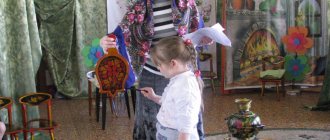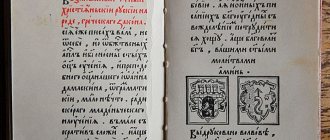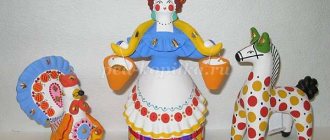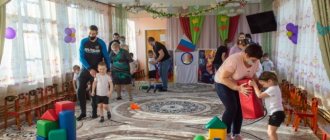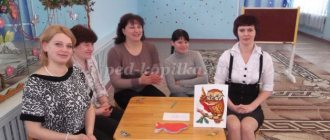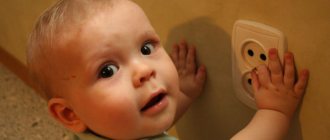Target:
teach children to see, evaluate the current situation, and come up with ways to solve it.
Progress of the lesson
Teacher (suggests a situation): Petya is home alone. The bell rings. A child’s voice behind the door: “I live on the floor above, I went out to take out the trash, and the door to my apartment slammed. The keys were left at home. I'm cold and don't know what to do. Help me!" What could happen next? Children: - Petya will open it, and then he’ll come up with something. For example, he will call the police, call his parents, neighbors. “He’ll try to break the lock, and if that doesn’t work, he’ll invite you home.” Let it warm up. - No, Petya definitely won’t open it! Is it dangerous. What if it was the bandits or the gypsies who changed their voice? Adults can speak in a child's voice. But Petya doesn’t see who’s standing behind the door.
“And on our balcony the window looks out onto the entrance, and you can see who’s standing at the door.” If it's a child, you can open it. (Children agree.) Teacher: Is it safe?
Children: What if bandits or gypsies persuaded the boy to ask for help for a toy? And when Petya opened it, they burst in. No, he won't open it. Yes, it's better not to open it. Teacher: Do you think it’s better not to open it? But perhaps the boy is in trouble and asks for help. And Petya will refuse? Children: -We need to come up with something without opening the doors. You can call the police and tell the address, they will come and help. And if there are bandits, they will take it. —You can shout for help from the balcony, knock on the neighbors’ walls.
Teacher: Well, what if Petya lives high? If he screams, no one will hear. And the neighbors may not be at home. Children:
“Then you can throw a bag of water onto the street, it will burst, people will raise their heads up, and Petya will send them a letter for help.”
- No, you can pour on people, and then Petya will be scolded.
— Petya should ask for his parents’ phone number and call them. That's all.
- What if the boy doesn’t remember?
Teacher: What if the boy doesn’t have a phone at home? What will he do? How can Petya help the boy without putting himself in danger? (The children are asked to break into pairs and play out the current situation. A screen door is placed. Task: Vasya must convince Petya to help him, and Petya must do something without putting himself in danger. Next, three pairs of children act out this situation. The next option turned out to be the most successful and, in the opinion of the children, solved the problem. Ira in the role of the boy, Arina in the role of Petya.) Boy (crying, persuading): Open up! Petya: I won’t open it. And don't cry. You can't open the door with tears! Boy: But I'm cold, help me! (Very pitifully.) Imagine yourself in my place! Help, open it! (The boy first emphasized that Petya should open the door immediately, then he began to motivate by saying that he was cold, and then he invited Petya to try the situation on himself.) Petya: Calm down, I won’t leave you. Now we’ll come up with something... (Pause.) First, start jumping, it’s warmer as you move. (The boy jumps.) Boy: Well, what next? Petya: Try ringing the doorbell of neighbors living on another floor. There will definitely be adults at home somewhere. Exactly, Aunt Tanya lives on the third floor, she has a telephone. Run to her and call the police. Hurry up before you freeze. Boy (meaningfully): Well, thank you, I helped. Teacher: Did Petya help the boy without opening the door? Children: Yes! The most important thing is that Petya was not in any danger. And the boy, following Petya’s advice, will definitely find help from other neighbors. Teacher: Would everything have ended so well if Petya had opened the door? Children: Yes and no! Anything could happen! Teacher: Continue at home with your parents to compose a story in which Petya opened the door.
Life Safety Project. "Want to know everything. Home alone" (senior preschool age group)
Transcript
1 Municipal budgetary preschool educational institution kindergarten 48 “Rostok” Project on life safety “I want to know everything. Home alone” (senior preschool age group) Completed by: teacher Kuznetsova E.V. Surgut 2016
2 Project: short-term. Project type: creative informational Project duration: 1 week. Project participants: children of the senior group, teachers, parents The goal of the project: the formation of conscious correct behavior that allows you to avoid the situation at home. Consolidating knowledge about safety rules when dealing with household appliances and sharp objects, promoting caution when communicating with strangers. Objectives: To form in preschoolers an idea of objects that are dangerous to life and health that are found in everyday life; Teach to follow certain rules of behavior at home; To stimulate the development of independence and responsibility in preschoolers; Develop attention, memory, instinct of self-preservation. Project participants: teachers, children and their parents. Planned result: children of senior preschool age, who know and follow the rules of safe behavior at home, are able to act in various situations. Integration of educational areas: Social communicative development Cognitive development Artistic and aesthetic development Physical development Speech development. The main forms of project implementation: conversations, direct educational activities, children's artistic creativity, didactic games, training competitions, reading fiction, working with parents. Project stages: Preparatory. Working with parents Goal: to increase parents’ literacy in developing children’s knowledge about the rules of safe behavior at home. Questionnaire; Consultations: “Safety in your home”, “Dangerous situations in the lives of children”, “Whether to leave a child alone at home”; Leisure for children and parents: “Every little child should know this from the cradle” KVN for children and their fathers “Home Alone”
3 Conversations Artistic creativity Direct educational activities All this work contributes to the development of parents' interest in forming the foundations for safe behavior of children at home. Implementation of the project Work with children is carried out throughout the week. Each day of the week has its own general structure: a name, the purpose of the day, and at the end of the day the results are summed up. Topics of the day: Monday: “Child at home (be careful with water)” children should know that in the house they need to be careful with the water coming from the tap. Tuesday: “Household items can be dangerous. Electrical Appliances in the House" children should know that electric current helps people, but it can be dangerous. Wednesday: “Pills are not candy” children should know that tablets, even the most beautiful ones, should never be put into the mouth. Thursday: “In the World of Dangerous Objects” children should know which objects cannot be taken, which ones can only be taken with adults, which ones can be used independently, but carefully. Friday: "Stranger Danger" Children should know that they cannot communicate with strangers. Monday Topic of the day: “Child at home (be careful with water).” Goal: explain to children what situations may arise at home, how to act correctly in these situations, and how they can be avoided. Conversation “Dangerous situations at home.” Reading fiction: T.A. Shorygina, fairy tale “Flood in a Doll’s House”; G. Blinov, “The Adventures of Stobed.” Finger gymnastics “Wash your hands clean and clean.” Role-playing game "Hospital". Didactic game "Do's and Don'ts".
4 Examination of the “What Happened” poster. Conversation “So that there is no trouble.” Training competition “Lay out correctly.” Writing stories on the topic “What would happen if?” Productive activity (drawing) “Dangerous places in my house.” Tuesday Topic of the day: “Household items can be dangerous. Electrical appliances in the house." Goal: to strengthen children’s understanding of electrical appliances, their meaning for people, and the rules for using them. Watching the animated film "Cat's House." Conversation “Current runs through wires.” Reading fiction: G. Blinov, “Stobed and the Naughty Socket”, S.Ya. Marshak “Fire”. Guessing riddles on this topic. Didactic games: “Right and Wrong”, “The Fourth Wheel”. Role-playing game “Electrical Appliance Store.” Conversation “What kind of fire is there?” Examination of subject pictures. Looking at the poster “Fire Extinguisher Tips.” Productive activity (drawing): invite children to draw signs “Do not use yourself”, “Use with caution”. KVN for older children and their fathers. Goal: increasing the role of the father in the family, in the upbringing and education of preschool children. Help fathers learn to respect their child as an individual. Wednesday Topic of the day: “Pills are not candy.” Goal: to give children an idea of pills, their benefits and harms. Conversation “Medicine is not a toy.”
5 Reading fiction: G. Blinov, “Naughty Stobed Tells a Fairy Tale,” T. Shorygina, fairy tale “Careless Rezvushka.” Guessing riddles on this topic. Role-playing game in a pharmacy. Didactic games “Ascorbinka and her friends”, “Guess the taste”. Conversation “Vitamins and health.” Productive activity (drawing): invite children to draw and color pills, a bottle of medicine, vitamins and a cabinet where medicines are stored. Outdoor relay game “Medicines are friends or enemies.” Quiz "Safety Experts". Thursday Topic of the day: “In the world of dangerous objects.” Purpose: to clarify children’s knowledge about the rules for using piercing and cutting objects. Thematic lesson of GCD “The World of Dangerous Objects”. Reading fiction: T. Shorygina, the story “Danilka and the File”, the fairy tale “Good Advice”. Reading the poem “Dangerous Situations.” Conversation about small objects (buttons, peas, beads, carnations). Video recording “Lessons from Aunt Owl.” Didactic games “We have order”, “How to avoid troubles”. Role-playing game "Hospital". Productive activity: design of the exhibition “Dangerous objects in my house.” An evening of riddles: various dangerous and safe objects. Friday final event Theme of the day: “Stranger Danger.” Goal: to give children knowledge of how to behave correctly when meeting strangers. Conversation “Why a stranger can be dangerous.”
6 Reading fiction: Russian folk tale “Cat, Fox and Rooster”; chapters from A. Tolstoy’s fairy tale “The Adventures of Pinocchio”. Theatrical dramatization of the Russian folk tale "Kolobok". Didactic games “Guys from our yard”, “Right and wrong”. Role-playing game "City Travel". Ball game “Own. Stranger. Familiar". Examination of illustrations for S.T. Aksakov’s fairy tale “The Scarlet Flower”. Literary quiz “Experts of safety rules.” Compilation of stories on the theme “New Buddy”. Final event: leisure time for parents and children “Every small child should know this from the cradle” Project results: preschool children have formed an idea of situations and objects that are dangerous to life and health that are found in everyday life.
